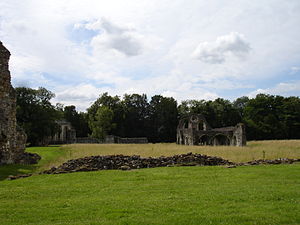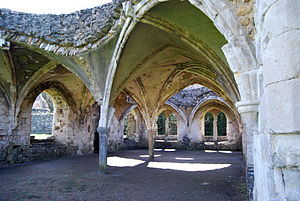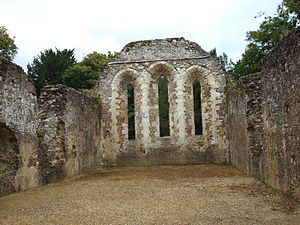- Waverley Abbey
-
Waverley Abbey was the first Cistercian abbey in England, founded in 1128 by William Giffard, Bishop of Winchester. It is situated about one mile south of Farnham, Surrey, in a bend of the River Wey.
Contents
History
During the first century of its existence, it founded six monasteries, and despite the members thus sent away, it had 70 monks and 120 lay brothers in 1187. It kept about thirty ploughs.
The site was subject to regular flooding, however, and in 1203 the foundations for a new church and monastery were laid on higher ground. The new church was dedicated in 1231.
King John visited Waverley in 1209, and Henry III in 1225. The abbey also produced the famous annals of Waverley, an important source for the period.
By the end of the thirteenth century the abbey was becoming less important. By the time it was suppressed by Henry VIII in 1536 as part of the dissolution of the monasteries there were only thirteen monks in the community and the abbey had an annual net income of £174.
Stones from the abbey when it lay in ruins were taken to build nearby houses, including the house at Loseley Park.
The ruins of Waverley Abbey are managed today by English Heritage. The sign at the entrance to the ruins states that it was the inspiration for Sir Walter Scott's novel Waverley.[1] However, this is probably not the case. Sir Walter Scott chose to adopt the name for his fictional hero Edward Waverley, the heir to an estate in southern England who travels north and becomes embroiled in the Jacobite uprising of 1745.[2] Waverley Abbey was, however, featured in Arthur Conan Doyle's classical romance, Sir Nigel. It was the scene of his winning of his war horse, Pommers, and his youthful embarrassment of the avaricious abbey authorities.
The ruins
A noteworthy piece of the ruins is the undercroft of the lay brothers' refectory. A section of 13th century vaulting still exists, supported by slender columns with circular capitals. The south gabled end stands almost to full height, displaying two pairs of lancet windows at the lowest level, with a single traceried window above each pair, and a central round window between those.[3] The walls are faced in rough flintwork.
19th century
Waverley was purchased by Florence Nightingale's family, and she visited the mansion frequently. It became a Red Cross hospital during the First World War, and after World War II it was converted into apartments for retired people.
World War II
At least two BBC TV programmes have claimed that the site of Waverley Abbey formed part of the defences of London set up in World War II. The defence was called the "GHQ Line". These claims are at least partly supported by the brick gun emplacement forming one side of the car park, and the multitude of tank traps[4] along the bank of the River Wey at the back of the abbey. It was said that the large open space, formed by the curve of the river on one side and the lake on the other, was intended to be a "tank killing ground" for any German army intending to outflank London's defences.
Filming
The abbey ruins have been used as a location in the filming of a number of films and television dramas, most notably as the setting for an idyllic interlude in Danny Boyle's 2002 film 28 Days Later.
The following productions include scenes filmed in Waverley Abbey:
- Invasion (2001, miniseries)[5]
- 28 Days Later (2002)[6]
- Elizabeth: The Golden Age (2007, film about Elizabeth I of England)[7]
- Animal Soup (2009, video)[8]
- Creation (2009, film about Charles Darwin)
Abbots of Waverley
The following is a list of the abbots of Waverley Abbey.[9]
- John, died 1128
- Gilbert, 1128-9
- Henry, died 1182
- Henry of Chichester, 1182, resigned 1187
- Christopher (abbot of Bruerne, Oxfordshire), 1187, removed from office 1196
- John II. (hospitaller), 1196, died 1201
- John III. (cellarer), 1201, died 1216
- Adam (sub-prior), 1216, resigned 1219
- Adam II. (abbot of Garendon, Leicestershire), 1219, resigned 1236
- Walter Giffard (abbot of Bittlesden, Bucks), 1236, died 1252
- Ralph (abbot of Dunkewell, Devon), 1252, resigned 1266
- William de London, 1266
- William de Hungerford, resigned 1276
- Hugh de Leukenor, 1276, died 1285
- Philip de Bedwinde, 1285
- William, occurs 1316
- Robert, occurs 1335
- John III., 1344
- John IV., 1349, died 1361
- John de Enford, occurs 1385-6
- William Hakeleston, 1386, died 1399
- John Brid, 1399–1400
- Henry, occurs 1433
- William, occurs 1452
- William Martyn, 1456
- Thomas, occurs 1478 and 1500
- William, occurs 1509
- John, occurs 1529
- William Alyng, occurs 1535
References
- ^ Waverley borough
- ^ Waverley Abbey
- ^ Heritage trail
- ^ Adrian Fletcher’s Paradoxplace – Waverley Abbey and British Cistercian Abbeys – Photos
- ^ "Invasion". Internet Movie Database. http://www.imdb.com/title/tt0414743/.
- ^ "28 Days Later...". Internet Movie Database. http://www.imdb.com/title/tt0289043/.
- ^ "Elizabeth: The Golden Age". http://www.movie-locations.com/movies/e/ElizabethGoldenAge.html.
- ^ "Animal Soup". Internet Movie Database. http://www.imdb.com/title/tt1590271/.
- ^ Malden, Henry Elliot (1914). The Victoria history of the county of Surrey. 2. London: A. Constable. pp. 77–89.
External links
- Visitor information and audio tour: English Heritage
- 19th century account of the abbey
- Map showing Waverley Abbey
- Detailed historical record for Waverley Abbey
Monasteries in Surrey Bermondsey Abbey · Chertsey Abbey · Guildford Black Friary · Friary of Crutched Friars at Guildford · Horsley Priory · Oxenford Farm · Merton Priory · Newark Priory · Sheen Friary · Sheen Priory · Southwark Cathedral · Syon Priory · Tandridge Priory · Wanborough Grange · Waverley Abbey
Categories:- English Heritage sites in Surrey
- Monasteries in Surrey
- Cistercian monasteries in England
- Visitor attractions in Surrey
- Ruins in Surrey
- Religious organizations established in the 1120s
- 1128 establishments
- Christian monasteries established in the 12th century
Wikimedia Foundation. 2010.




